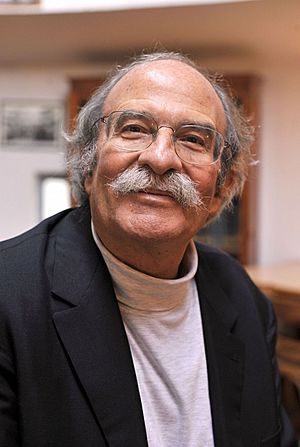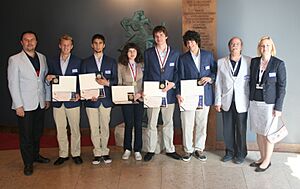John Hugh Seiradakis facts for kids
Quick facts for kids
John Hugh Seiradakis
|
|
|---|---|

Profile photo of John H. Seiradakis (2014)
|
|
| Born | 5 March 1948 |
| Died | 3 May 2020 (aged 72) Thessaloniki, Greece
|
| Nationality | Greek |
| Known for |
|
| Children | Elena, Michael |
| Awards |
|
| Scientific career | |
| Fields | Physics, Astronomy |
| Institutions |
|
| Thesis | A low latitude pulsar survey at 408 MHz |
| Doctoral advisor | John G. Davies |
| Influenced | Vicky Kalogera Michael Kramer (astronomer) |
John Seiradakis (born March 5, 1948 – died May 3, 2020) was a famous Greek astronomer. He was a professor at the Aristotle University of Thessaloniki. He is well-known for his work on radio pulsars, the center of our Milky Way galaxy, and archaeoastronomy. He also played a big part in understanding the ancient Antikythera mechanism.
Contents
About John Seiradakis
John Seiradakis was born in Chania, Crete, Greece, on March 5, 1948. His mother was a British archaeologist. He finished high school in Athens.
His Education Journey
He studied Physics at the National and Kapodistrian University of Athens. He earned his degree in 1971. Then, he moved to the Victoria University of Manchester in England. There, he earned his Master's degree (M.Sc.) in 1973. He also got his Ph.D. (Doctor of Philosophy) in Radio Astronomy in 1975.
His Family
John Seiradakis had two children. His daughter, Elena, is a professor at Oxford University. His son, Michael, is a medical doctor in Germany. John Seiradakis passed away on May 3, 2020, in Thessaloniki.
His Amazing Career in Astronomy
John Seiradakis did his Master's and Ph.D. projects with Dr. John G. Davies. His Ph.D. work was about finding new pulsars. Pulsars are like cosmic lighthouses. They are very dense, spinning stars that send out beams of radio waves. His research found 18 new pulsars. This was a big discovery at the time.
Working with Radio Telescopes
After his Ph.D., Seiradakis worked in Germany. He was at the Max Planck Institute for Radio Astronomy. He helped build new tools for studying pulsars. He also used the huge 100-meter Effelsberg 100-m Radio Telescope. He visited this institute many times during his career.
In 1978, he became a researcher at the University of Hamburg. He studied how neutral hydrogen is spread out in nearby galaxies.
From 1982 to 1984, he worked at the University of California, San Diego. He continued his research on pulsars. He also studied how radio waves from space shimmer, like stars twinkle.
Exploring the Galactic Center
In 1984, John Seiradakis and his team studied Sag A*. This is a very bright radio source at the center of our Milky Way galaxy. They found a strange, extended radio source there. It looked like jets coming from the very center of the galaxy.
Professor in Greece
In 1986, he joined the Aristotle University of Thessaloniki in Greece. He became a full Professor in 1996. He worked on many topics. These included neutron stars (pulsars), how hydrogen is spread in galaxies, and the Galactic Center. He also studied flare stars and Archaeoastronomy. This is the study of how ancient people understood the sky. He wrote many scientific papers and textbooks.
He helped create the Hellenic Astronomical Society. He was its Secretary and later its President. He also led the Greek National Committee for Astronomy.
Unlocking the Antikythera Mechanism
The Antikythera mechanism is an ancient Greek device. It's like a very old, hand-powered computer. It was found in 1900 in a shipwreck. In the early 2000s, John Seiradakis became deeply involved in studying it. He led the Greek team in this big project.
They used new scanning techniques to look inside the mechanism. This led to amazing discoveries about how it was built and how it worked. It could predict the movements of the Sun, Moon, and planets. Professor Seiradakis gave many talks around the world about these discoveries.
Inspiring Young Astronomers
John Seiradakis loved teaching and sharing his knowledge. He helped many students become astronomers. Many of them now work as researchers in Greece and other countries.
He also helped start the International Olympiad on Astronomy and Astrophysics (IOAA). This is a worldwide competition for high school students who love astronomy. It's now one of the major International Science Olympiads. John Seiradakis represented Greece on the IOAA board. He also led the Greek team for many years.
Images for kids



